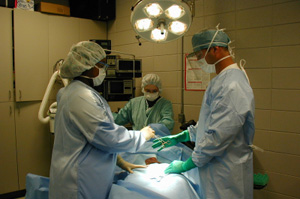 There are 206 bones in the human body, and together they provide many functions that are critical to our health and wellbeing. When bones are fractured, the recovery process can be lengthy and expensive, especially in more severe cases entailing surgery and traction. Motor vehicle accidents, falls and sports injuries are the leading causes of broken bones, which are considered a medical emergency.
There are 206 bones in the human body, and together they provide many functions that are critical to our health and wellbeing. When bones are fractured, the recovery process can be lengthy and expensive, especially in more severe cases entailing surgery and traction. Motor vehicle accidents, falls and sports injuries are the leading causes of broken bones, which are considered a medical emergency.
Even minor hairline fractures should be evaluated and treated promptly to prevent further complications. Improper or delayed treatment of fractures can result in incapacitating changes to your mobility, ongoing pain and loss of bone integrity. X-rays must be taken to diagnosis the injury and provide a clear idea about the type of fracture and the degree of bone displacement. When such personal injury is caused by another party’s negligence, victims may be eligible to seek monetary damages through the courts.
The law firm of Kantrowitz, Goldhamer & Graifman has a long history of success litigating claims involving bone fractures and other traumatic injuries. The following is a brief outline of the different types of bone fractures and their characteristics.
Types of bone fractures
There are two basic categories of bone fractures: simple and compound fractures. Simple fractures, also known as closed fractures, are broken bones that do not pierce or puncture through the skin.
Compound fractures, also called open fractures, are broken bones that puncture the skin, exposing the bone and deep tissues. These fractures are much more serious because pathogens are able to enter the body, causing life-threatening infection. Broad spectrum antibiotics are administered to help prevent infection within the bone, blood and surrounding tissue.
Within the framework of compound and simple fractures, there are additional types of fracture injury:
- Comminuted fractures are one of the most crippling of injuries, when the bone breaks into multiple, small fragments. Often seen in crush injuries.
- Greenstick fractures are typically only seen in young children whose bones are still developing. Greenstick fractures are incomplete, meaning the bone doesn’t fully break.
- Avulsion fractures occur when a small portion of bone is ripped away, usually due to sudden traumatic pulling forces during an accident.
- Transverse fractures form horizontal to the long axis of a bone and are the result of a force applied at a right angle to the bone.
- Oblique fractures occur when the bone is fractured from a force that is applied in a direction other than a right angle.
- Spiral fractures can happen when the bone is actually twisted due to extreme external forces.
- Linear Fracture when the bone is fractured in a parallel manner along the long axis
Common bone fractures seen in accidents
Bones that are often fractured in car, truck and construction accidents include:
- Wrist/hand
- Pelvis
- Clavicle
- Humerus
- Scapula
- Radius
- Femur
- Spine
- Tibia/Fibula
Arm bones may heal within 4-5 weeks, whereas a leg fracture could take up to 8 months. Age also plays a crucial role in the body’s ability to heal. Younger children will recover faster, while the elderly may never fully recover from a broken leg, hip or other traumatic bone fracture.
Schedule a free case review in New York or New Jersey
A favorable verdict or settlement can make a world of difference for those who have suffered debilitating bone fractures in preventable accidents. Kantrowitz, Goldhamer & Graifman attorneys are dedicated to fighting for your rights. To learn more about your options for legal recourse, we encourage you to reach out for a free consultation with an experienced personal injury lawyer at our firm. All cases are handled on a contingency basis.
Additional Bone Fracture Resources:
- OrthoInfo, Fractures (Broken Bones) http://orthoinfo.aaos.org/topic.cfm?topic=a00139
- WebMD, Understanding Bone Fractures — the Basics http://www.webmd.com/a-to-z-guides/understanding-fractures-basic-information
- InnerBody, Types of Bone Fractures http://www.innerbody.com/image/skel06.html






